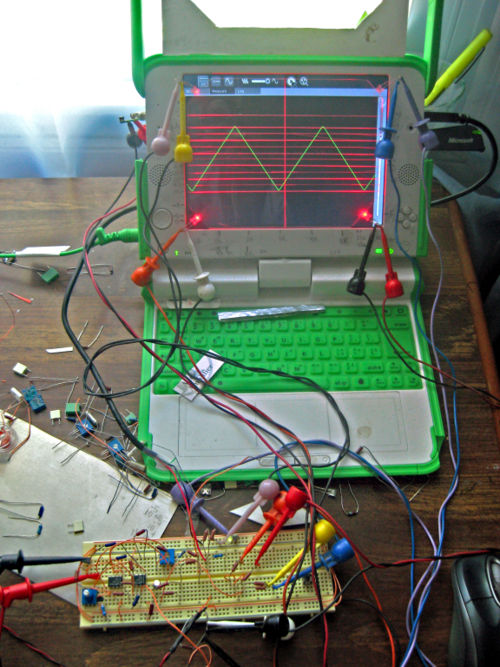The printable version is no longer supported and may have rendering errors. Please update your browser bookmarks and please use the default browser print function instead.
Lighted Graticule
A graticule is a "scale on transparent material on the focal plane of a optical instrument for the location and measurement of objects" (Webster's Ninth Collegiate Dictionary, 1990, Merriam-Webster Inc, Springfield MA).
The following describes the design of a lighted graticule that works together with a 50:1 (attenuating-) probe (similar to the one described at Measure/Projects/Oscilloscope probe ) to provide the teacher and student with calibrated measurements as displayed on the screen in 1 volt per major division, or 0.10 volt per major division, or 0.010 volt per major division.
Introduction -- What is a graticule?

A concept breadboard: The graticule is a piece of 0.093 inch thick acrylic plastic with lines scratched in it -- it fits nicely in the laptop's window. (The lines are on the side closest to the screen). The illumination comes from 4 red high-output T-1 3/4 Radio Shack LEDs sanded down to 0.093 thick and then super-glued to each corner cut at a diagonal -- a critical trick is to couple as much of the light into the plastic as possible. (For some unknown reason the upper right LED bit the dust after working for awhile -- hypothesis is these LEDs don't like reverse voltage accidentally applied to them.) Each LED is being driven with the +5 volts from the laptop through its own 499 ohm resistor. With these high-intensity LEDs this is more than enough light; a single potentiometer might serve to provide an overall intensity-adjustment.) As the bright corner LEDs are a bit distracting, a finished graticule requires a "mask" (partly visible at the top of the photo -- it is folded upward). The mask can also provide a good place to write numbers -- I'm writing with pencil on the laptop's bezel right now. I've found that red is the best color. I tried green and red (they mix to form yellow) but this did not have enough contrast. Blue might work and would look sharp-- e.g. a likely candidate is the high-intensity (1500 millicandellas) T-1 blue Kingbright LED lamp WP7104QBC/D gotten from www.mouser.com ($0.18 each in 100's.) A reddish-orange high-intensity T-1 LED (1300 millicandellas) is the WP7104SEC/E ($0.15 each in 100's). A red 900 millicandela T-1 is the WP7104SRC/E ($0.06 in 100's). Tinfoil along the edges to reflect the light back are visible on the laptop's keyboard -- not a very successful experiment. (I've polished the edges -- I've tried bevelling but the jury is out as to whether the LEDs' light can successfully enter at an angle.) The breadboard circuit shown here is a 1:50 attenuator plus an adjustable-gain amplifier -- final design TBD.
Oscilloscopes traditionally light the graticule by illuminating its edges; the graticule material (typically acrylic plastic) "pipes" the light through itself. If the piped light hits a line scratched in the plastic's surface, the light bounces off the scratch and illuminates the line.
When doing experiments that involve measurements, such lines become almost mandatory. Indeed, I decided I had to breadboard one up (see the photo) in the course of designing a waveform generator. I wanted to make measurements of the extremes of voltage that an LM358A operational amplifier can output when operated from 5 volts. (It turned out to be roughly 0.5 to 3.1 volts just like the spec sheet and calculations indicated.)
